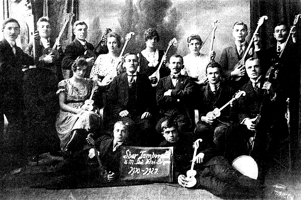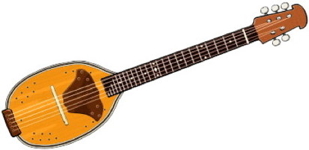
|
The Society of Folk Dance Historians (SFDH)
Tamburitza in History
[
Home |
About |
Encyclopedia | CLICK AN IMAGE TO ENLARGE |

|
 This is an interesting corner of tamburitza history, of which little is known. A few points, mainly concerning Vojvodina (aka Vajdasag).
This is an interesting corner of tamburitza history, of which little is known. A few points, mainly concerning Vojvodina (aka Vajdasag).
Tamburitza was in a big growth phase among the Croatians and Serbians of Austria-Hungary from about 1870-1914. Much of this was apparently spurred political/cultural activists who promoted tamburitza as a national form of expression. The audience for this activity was mainly the provincial middle classes, who took up tamburitza and musical training along with political consciousness raising. Particularly among Croatians, there was also a successful effort to promote tamburitza among village agricultural workers. Nonetheless, Hungarians adopted it fairly early on as well, both farmers and city people &150; I have pictures of Hungarian orchestras from the early 20th century.
By the end of the 19th century, there were dozens of small Croatian and Serbian (and a few Hungarian) professional ensembles (four to six players) touring throughout Europe. Their repertoire was a mix of "national" songs, arrangements of light classics, and international pop hits of the day – many current orchestras still have such a mix, although heavier on local material. There are Croatian and Serbian (and a few Hungarian) composers who have written pieces in classical style for larger tamburitza ensembles (twenty or more); there are still quite a few of these groups in Croatia and Vojvodina, Serbia.
My guess is that tamburitza appealed to rural people as an upper-class form, as did military music. The village music of South Slavs is mostly frula and bagpipes (flute, gajda), as it is for Hungarians (although there has been a great revival of interest in citera (zither) among Hungarians. Tamburitza is a pretty social form of music, and I believe that sociability, coupled with bourgeois associations and "modern" repertoire, contributed to its popularity.
The repertoire of the Vojvodina Hungarian tamburaši is largely nota (that is, songs and dances popularized by urban Hungarian Rom orchestras) – all that I knew played this music enthusiastically and many had scores from Hungary. The Vojvodina dance repertoire seemed to me to consist of standard nota Csárdás's – although the Hungarian population of Vojvodina is diverse (including some Transylvanian< villages), the dance repertoire that survived into the 1970s was very small – circle and couple Csárdás with little variation.
It's not known exactly when Romani began to be involved with tamburitza, although in one account, it was Backa Rom who provided the model for the first known tamburitza orchestra, founded by Croatians in Osijek in 1847. However, by the 1930s, they dominated professional tamburitza playing in Vojvodina. Romani tamburaši seem to have been culturally aligned with their audiences – some specialized in Hungarian< and others in Serbian< or Croatian< material. While most Vojvodina musicians of any kind knew at least a few tunes from all the ethnic groups (everybody, for example, knows Az a szep), you wouldn't hire "Hungarian Romani" for a Serbian wedding. The notable exception was the orchestra of Janika Balas; a "Hungarian" Rom Ruthenian songs, as well as international favorites.
Around Subotica and Sombor, where the Croatian< minority Bunjevci are numerous, there's a lot of interaction between Bunjevac and Hungarian tamburaši – many play together and know much of the same repertoire. Again, there were close cultural ties between the two groups; many town-dwelling Bunjevci are still fluent in Hungarian.
Until 1980 or so (when most had retired or passed away), the top-flight professional tambura craftsmen were >Hungarian – Kudlik in Subotica, Lajos in Senta, Beli and Gez in Novi Sad. In fact, Hungarians dominated most crafts until fairly recently.
Younger Hungarians have become interested in the Hungarian folk music revival; I've even heard of tanchaz being organized in some of the towns with big Hungarian populations. As far as I can tell, the younger musicians aren't performing anything from Vojvodina; it's mostly from Transylvania and other areas of Hungary. Like their contemporaries elsewhere, they share a disdain for nota; I'm sure some older folks there see the irony of old tamburitza musicians and young bagpipers.
That's about it for me.
Cheers
–Mark Levy
DOCUMENTS
- Balkans, a region.
- Croatia, a country.
- Dobar Dan Tamburica Orchestra, an article.
- Learn to Play Bulgarian and Macedonian Tambura, an article.
- Serbia, a country.
- Tamburitza Association of America, an organization.
- Yugoslavia, a former country.
This page © 2018 by Ron Houston.
Please do not copy any part of this page without including this copyright notice.
Please do not copy small portions out of context.
Please do not copy large portions without permission from Ron Houston.